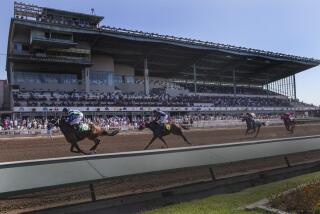Perro Agauyo Jr. died from heart attack, stroke caused by broken neck

- Share via
Perro Aguayo Jr., a legendary pro wrestler in Mexico who died Friday while competing in a match, died from a heart attack that was brought on by a cervical stroke suffered due to a broken neck, according to Ernest Franco, the official doctor for the Tijuana Wrestling Commission said Tuesday.
Juan Carlos Pelayo, the president of the Tijuana Wrestling Commission, said that there was no negligence in the death of Aguayo. The promotion that Aguayo was wrestling for, Crash, had two ambulances, five paramedics and a doctor at the arena.
There was much criticism of the apparent slowness in help arriving for Aguayo, who remained unconscious in the ring as the match continued around him. Former wrestler Konnan, who was ringside, shook Aguayo a couple of times in an apparent attempt to revive him before medical personnel arrived. According to the TWC, it took 80 seconds for a doctor to arrive. There are many videos of the incident on YouTube.
Aguayo, who was buried Monday in Guadalajara, was “a gigantic star in Mexico, the top rudo, or villain in the country,” according to pro wrestling reporter and creator of the Wrestling Observer Newsletter, Dave Meltzer. When asked to name an equivalent WWE wrestler, Meltzer said, “I’d say very much the level of a HHH from several years back or Seth Rollins, if Rollins remains in his position for 10-15 more years. Randy Orton may be the best comparison, but I’d say bigger than Orton, maybe even like Randy Savage.”
As far as the controversy regarding how the situation was handled after Aguayo was injured, and if it will lead the changes in how in-ring injuries are treated, Meltzer said, “I don’t see much changing in the U.S. In Mexico, I’m not sure what will change past maybe people knowing to instinctively stop the match and carefully bring him to the back. It was actually good a doctor was there and an ambulance was there and they were only a few blocks from a hospital. In that sense, they were lucky.
“But the doctor did get there late because he was treating someone. Because this was so big, in Mexico, I think it will change the instincts of people from the knowledge of what happened, but as far as ... regulatory changes, perhaps there will be more commissions demanding more medical care at shows for a while. In the U.S., because wrestling is largely unregulated, I don’t see anything coming from this. WWE has trained medical personnel at every show, but smaller groups that draw 100 people don’t have the budget for hospitals and ambulances.”
More to Read
Go beyond the scoreboard
Get the latest on L.A.'s teams in the daily Sports Report newsletter.
You may occasionally receive promotional content from the Los Angeles Times.











